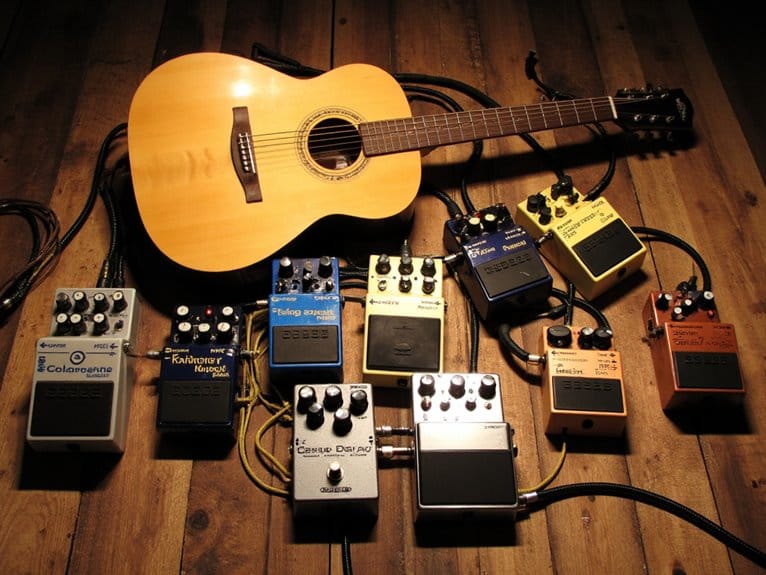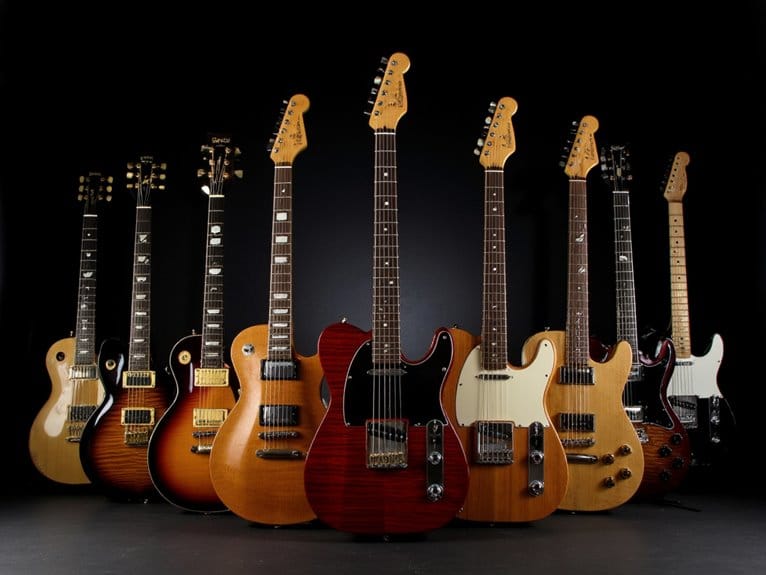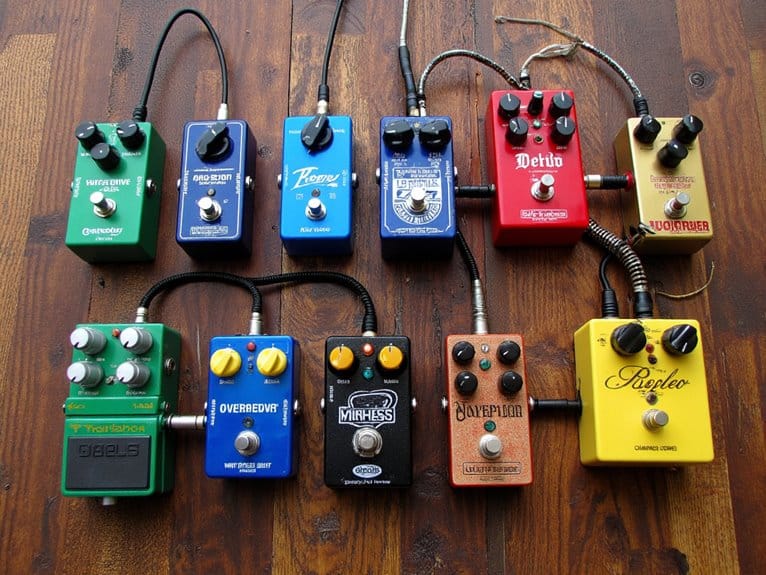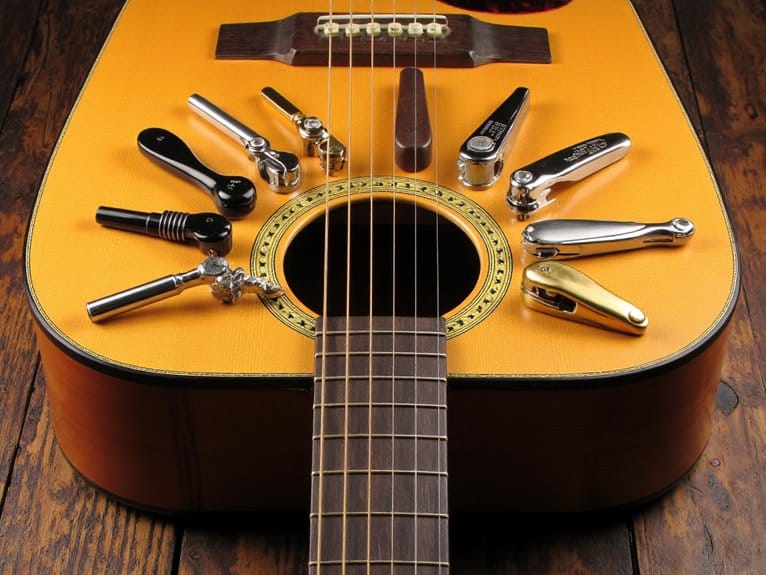10 Best Delay Pedals for Acoustic Guitar That Will Transform Your Sound
After testing dozens of delay pedals on my acoustic guitars, I’ve found that the SONICAKE Acoustic Guitar Effect Pedal with XLR output, Fishman AFX EchoBack Mini, and L.R. Baggs Align Delay consistently deliver the most natural-sounding echoes that enhance rather than mask your guitar’s organic tone. These pedals offer essential features like tap tempo, true bypass circuitry, and delay times ranging from quick 20ms slap-back effects to atmospheric 2000ms textures that’ll make your solo performances sound orchestral—and there’s much more to take into account when selecting your perfect delay companion.
We are supported by our audience. When you purchase through links on our site, we may earn an affiliate commission, at no extra cost for you. Learn more.
Notable Insights
- Analog delay pedals produce warmer, more natural-sounding echoes that complement acoustic guitars and preserve organic tone.
- Essential features include tap tempo functionality, true bypass circuitry, and XLR outputs for professional live performance applications.
- Short delays (20-100ms) create punchy slap-back effects, while longer delays (500-2000ms) generate atmospheric textures and spatial depth.
- Top-rated options include Fishman AFX EchoBack Mini, L.R. Baggs Align Delay, and SONICAKE multi-effects pedals for acoustic guitars.
- Choose pedals specifically designed for acoustic applications to maintain natural tone quality and seamless integration with your sound.
SONICAKE Acoustic Guitar Effect Pedal with Multi Effects & XLR Output
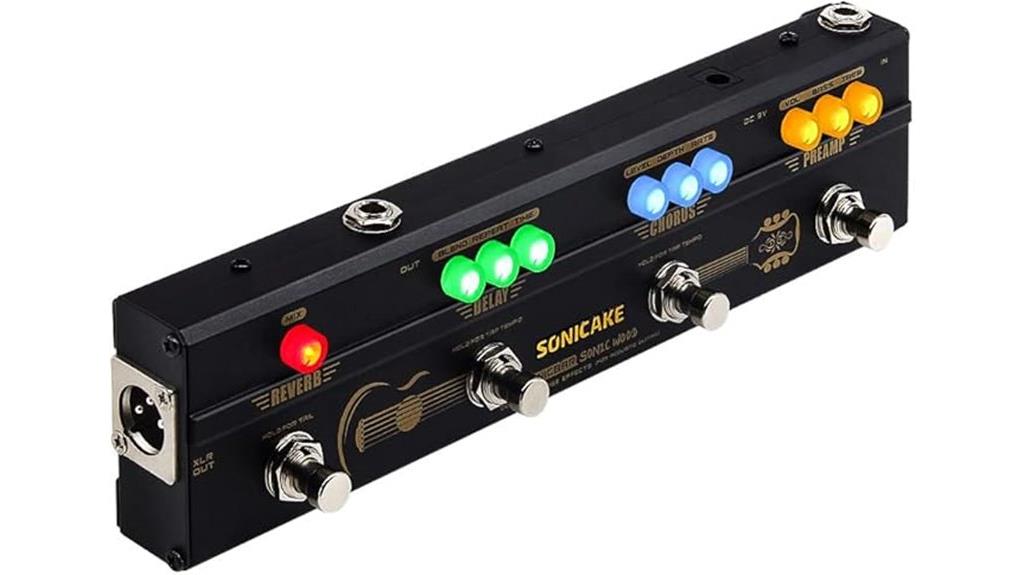
If you’re an acoustic guitarist seeking professional-grade effects without breaking the bank, the SONICAKE Acoustic Guitar Effect Pedal delivers impressive versatility through its multi-effects preamp that combines chorus, delay, and reverb in a compact 2.8 x 15.85 x 2.24-inch metal chassis. You’ll appreciate the delay’s blend, repeat, and time controls, which offer warm sound reproduction without compromising your acoustic guitar’s natural character, particularly when using passive pickups. The XLR output connects directly to PA systems, mixers, or audio interfaces, while the analog preamp’s 2-band EQ maintains sound integrity that’s earned this pedal 4.5 stars from 616 customer reviews.
Best For: Acoustic guitarists who want professional-quality chorus, delay, and reverb effects with XLR output capability for live performances and studio recording at an affordable price point.
Pros:
- Combines multiple high-quality effects (chorus, delay, reverb) with analog preamp and XLR output in a compact, durable metal chassis
- Maintains acoustic guitar’s natural sound integrity, especially with passive pickups, while offering warm sound reproduction
- Excellent value at $69 with intuitive controls, tap tempo functionality, and strong customer satisfaction (4.5 stars from 616 reviews)
Cons:
- Some users report slight noise added to the signal that may require additional equipment like mixer pads or noise gates to manage
- Preamp effectiveness doesn’t meet all users’ expectations, with mixed feedback on this particular feature
- Lacks additional effects like looper or tuner that some performers need for comprehensive live performance setups
Delay Pedal for Electric Guitar, Analog DC 9V True Bypass
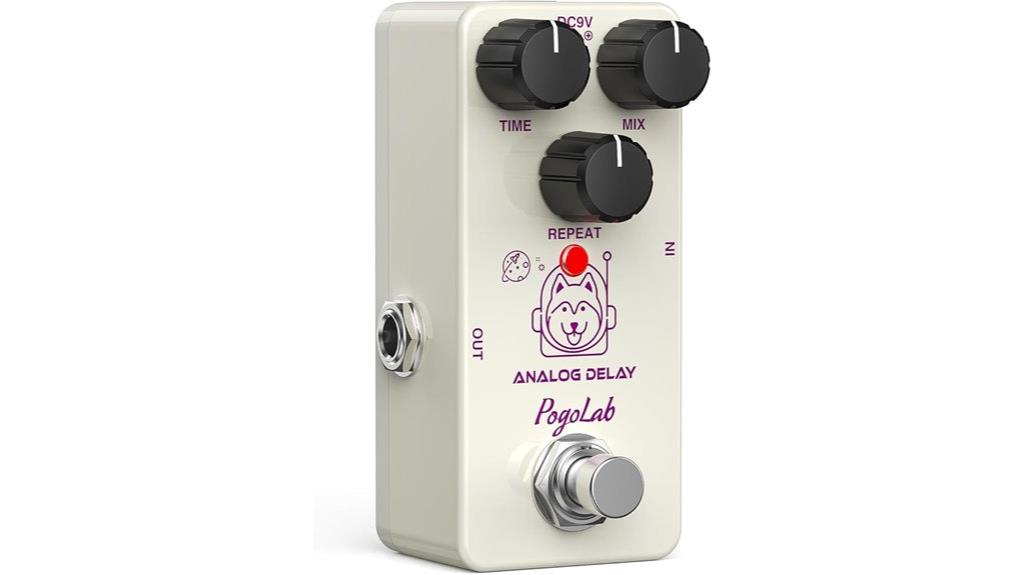
When you’re searching for an analog delay pedal that delivers warm, natural-sounding echoes without breaking the bank, the Pogolab Delay Pedal stands out as a compelling choice for guitarists who value both quality construction and affordability. This compact aluminum alloy unit measures just 3.62 x 1.93 x 1.85 inches, making it perfect for crowded pedalboards where real estate comes at a premium. The TIME and MIX controls provide intuitive operation, allowing you to dial in everything from subtle slapback echoes to expansive valley-like reverberations that enhance single-note sustain beautifully. True bypass circuitry maintains your signal integrity when disengaged, though some users notice minor idle hissing.
Best For: Guitarists seeking an affordable, compact analog delay pedal with warm, natural-sounding echoes that works well across different musical styles from shoegaze to acoustic enhancement. This pedal is perfect for musicians who want to integrate lush delay effects without overwhelming their setup. Its smaller sized delay pedal design ensures it won’t take up much space on your pedalboard, making it ideal for both studio and live performances. With intuitive controls, players can easily dial in the desired delay time and feedback, providing a user-friendly experience for any guitarist.
Pros:
- Solid aluminum alloy construction with true bypass circuitry maintains excellent signal integrity and durability
- Intuitive TIME and MIX controls allow versatile delay effects from subtle slapback to expansive valley-like reverberations
- Compact size (3.62 x 1.93 x 1.85 inches) fits easily on crowded pedalboards while delivering exceptional value for the price point
Cons:
- Minor hissing noise when idle, though it doesn’t affect playing sound
- DC 9V power cable and adapter not included with purchase
- Limited to basic delay functionality without advanced features like tap tempo or multiple delay modes
Fishman AFX EchoBack Mini Delay Pedal
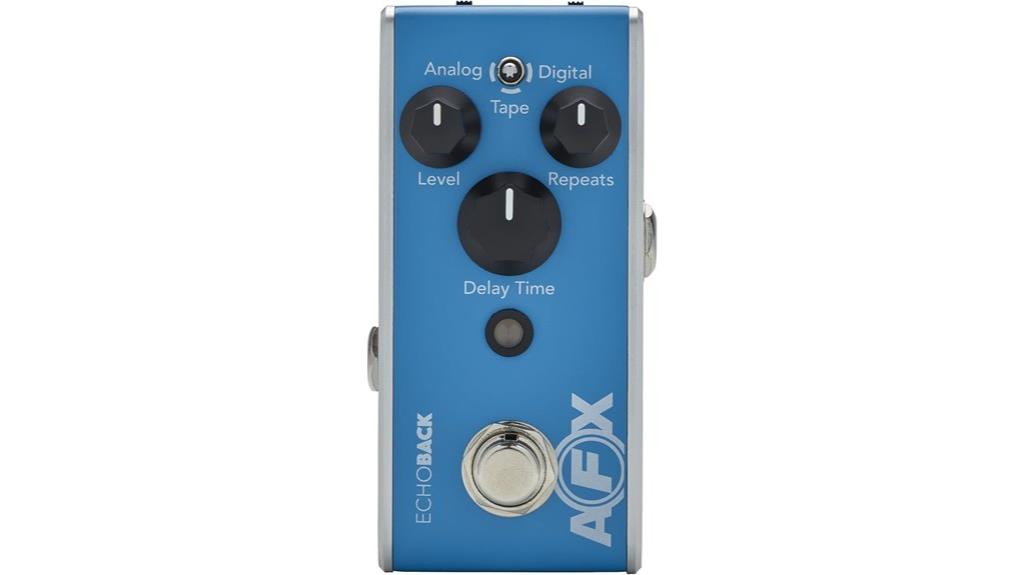
The Fishman AFX EchoBack Mini Delay Pedal stands out as an exceptional choice for acoustic guitarists who demand pristine tone preservation while adding sophisticated rhythmic depth to their performances. You’ll appreciate how this compact unit, weighing just 9.9 ounces, delivers three distinct delay types—analog, digital, and tape—mixed in parallel without compromising your guitar’s natural voice. The true buffered bypass and tap tempo functionality provide professional-grade control, while customers consistently rate it 4.8 out of 5 stars for its versatility and tone retention, making it an excellent value for both rhythm work and solo performances.
Best For: Acoustic guitarists seeking to add rhythmic depth and texture to their performances while maintaining their instrument’s natural tone quality.
Pros:
- Three delay types (analog, digital, tape) mixed in parallel for versatile sound options
- True buffered bypass and tap tempo provide professional-grade control features
- Compact 9.9-ounce design with excellent tone preservation that doesn’t color the original acoustic sound
Cons:
- Limited number of customer reviews (only 8 ratings) makes long-term reliability assessment difficult
- No mention of battery operation capability, appears to require external 9V power source
- Made in China manufacturing may concern users seeking domestically produced audio equipment
SONICAKE Delay Reverb 2 in 1 Guitar Effects Pedal Digital Levitate
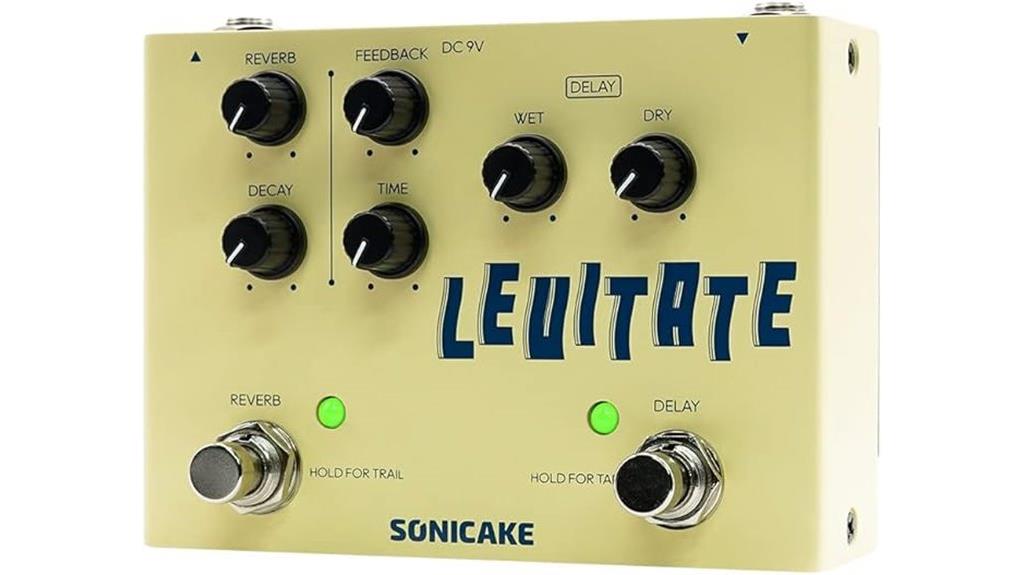
Budget-conscious acoustic guitarists seeking their first taste of professional-sounding delay and reverb effects will find the SONICAKE Delay Reverb 2 in 1 Guitar Effects Pedal Digital Levitate delivers surprising quality for its modest $50 price point. You’ll appreciate the intuitive dual-stomp design, which provides independent control over both effects without requiring an engineering degree to operate effectively. The 2000ms maximum delay time offers substantial creative flexibility, while the digital plate reverb adds atmospheric depth that complements acoustic instruments beautifully. Though it won’t replace studio-grade processors, this pedal’s robust metal construction and pristine buffer bypass circuit maintain your guitar’s natural tone integrity during live performances.
Best For: Budget-conscious guitarists who want to explore delay and reverb effects for the first time without breaking the bank, offering professional-sounding results at an accessible price point.
Pros:
- Intuitive dual-stomp design with independent controls that’s easy to operate without extensive learning curve
- Excellent value at $50 with robust metal construction and 2000ms maximum delay time for creative flexibility
- Maintains pristine sound quality through special buffer bypass circuit that preserves your guitar’s natural tone
Cons:
- Requires separate 9V center negative power supply which is not included in the package
- Not studio-grade quality, making it unsuitable for professional recording applications
- May serve only as an introductory pedal before upgrading to more advanced effects processors
L.R. Baggs Align Delay Acoustic Guitar Effects Pedal
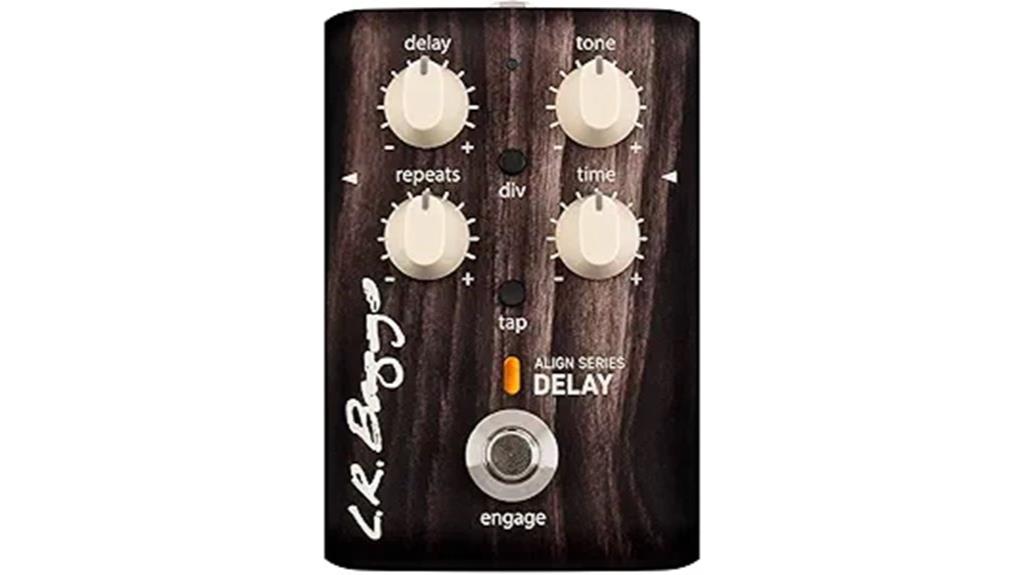
Solo acoustic performers who’ve struggled with thin, underwhelming sound during live performances will find their solution in the L.R. Baggs Align Delay, a pedal specifically engineered for high-fidelity acoustic instruments that combines analog warmth with digital precision. You’ll appreciate the thoughtful control layout, featuring delay blend, repeats adjustment, time settings, and a tone control that exclusively affects the repeats, allowing you to dial in everything from warm, vintage-style echoes to crystalline digital repeats. The division control sets delays to dotted eighth notes of your current tempo, while the tap button lets you establish precise timing or connect external devices for synchronized performance.
Best For: Solo acoustic performers and acoustic musicians who want to add rich, professional-quality delay effects to enhance their sound during live performances or recording sessions.
Pros:
- Specifically optimized for acoustic instruments with high-fidelity circuitry that maintains the natural acoustic tone
- Versatile tone control affects only the repeats, allowing seamless blending from warm analog-style to clear digital-style delays
- Intuitive tap tempo and division control features enable precise timing synchronization for professional performance integration
Cons:
- Limited to delay effects only, requiring additional pedals for musicians seeking other effect types like reverb or modulation
- Battery-powered operation may require frequent battery changes during extended live performances without AC adapter option mentioned
- Price point may be higher than general-purpose delay pedals due to acoustic-specific optimization and specialized circuitry
Amuzik Guitar Acoustic Simulator Pedal (LEF-320)
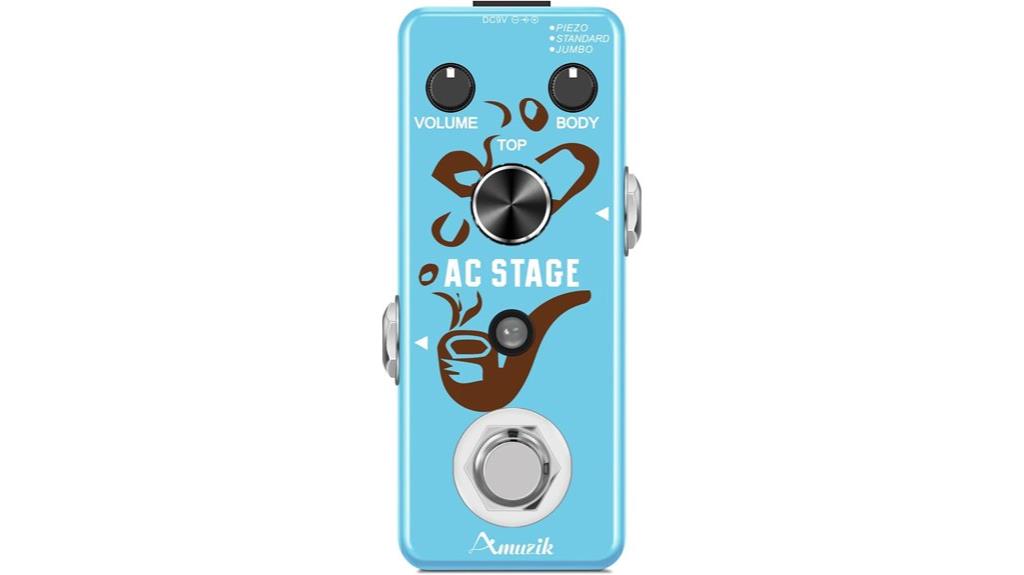
Electric guitarists who’ve always envied that warm, natural acoustic tone will find their solution in the Amuzik Guitar Acoustic Simulator Pedal (LEF-320), a compact analog processor that transforms your electric signal into convincing acoustic sounds. While it’s technically not a delay pedal, this simulator’s three distinct modes—Piezo, Standard, and Jumbo—offer varying acoustic characteristics from bright, crystalline tones to full-bodied, resonant sounds that’ll make your Stratocaster sound surprisingly like a Martin. The true bypass circuitry maintains your original signal integrity when disengaged, and the LED indicator provides clear visual feedback of the pedal’s operational status, making it a reliable addition to any pedalboard.
Best For: Electric guitarists who want to achieve authentic acoustic guitar tones without switching instruments, especially those performing live or recording who need versatile sound options in a compact, portable format.
Pros:
- Three distinct acoustic simulation modes (Piezo, Standard, Jumbo) provide versatile tonal options from bright to full-bodied sounds
- True bypass circuitry preserves original signal integrity when the pedal is disengaged
- Compact, sturdy design with LED indicator makes it reliable and easy to transport on any pedalboard
Cons:
- Power supply not included and must be purchased separately
- As an analog simulator, it may not perfectly replicate the complex resonance and dynamics of a real acoustic guitar
- Limited to acoustic simulation only, offering no additional effects or processing capabilities
Cube Baby AC Guitar Multi Effects Pedal (Delay Chorus Tremolo Reverb)
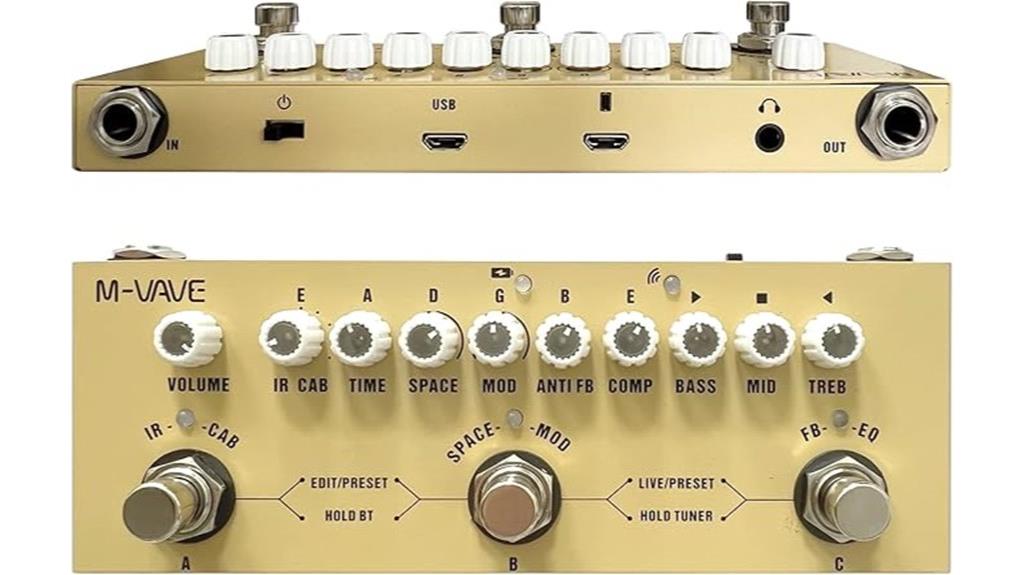
While many acoustic guitarists search for separate pedals to build their pedalboard, I’ve found that the Cube Baby AC Guitar Multi Effects Pedal offers a compelling all-in-one solution that combines delay, chorus, tremolo, and reverb effects in a single, portable unit. You’ll appreciate the three editable presets that let you customize your entire effects chain, while the intuitive operation keeps things simple during live performances. The built-in battery charges in two hours and provides six hours of playing time, making it perfect for outdoor gigs where power outlets aren’t available. The wireless accompaniment feature, activated by holding the A+B footswitches, adds versatility beyond traditional effects processing.
Best For: Acoustic guitarists who want a portable, all-in-one effects solution for both practice and live performances, especially those who perform outdoors or in venues without reliable power access.
Pros:
- Three customizable presets allow you to create and save different effects chains for various songs or performance situations
- Built-in rechargeable battery provides 6 hours of playing time with only 2 hours of charging, perfect for extended outdoor performances
- Combines multiple essential effects (delay, chorus, tremolo, reverb) in one compact unit, eliminating the need for separate pedals
Cons:
- Limited to only three preset slots, which may not be enough for guitarists with diverse setlists requiring multiple different sounds
- Battery-dependent operation means you could be left without effects if the battery dies during a performance
- All-in-one design means if one effect or function fails, you lose access to all effects rather than just a single pedal
Caline Reverb Delay Effects Pedal for Electric Guitar (CP-80)
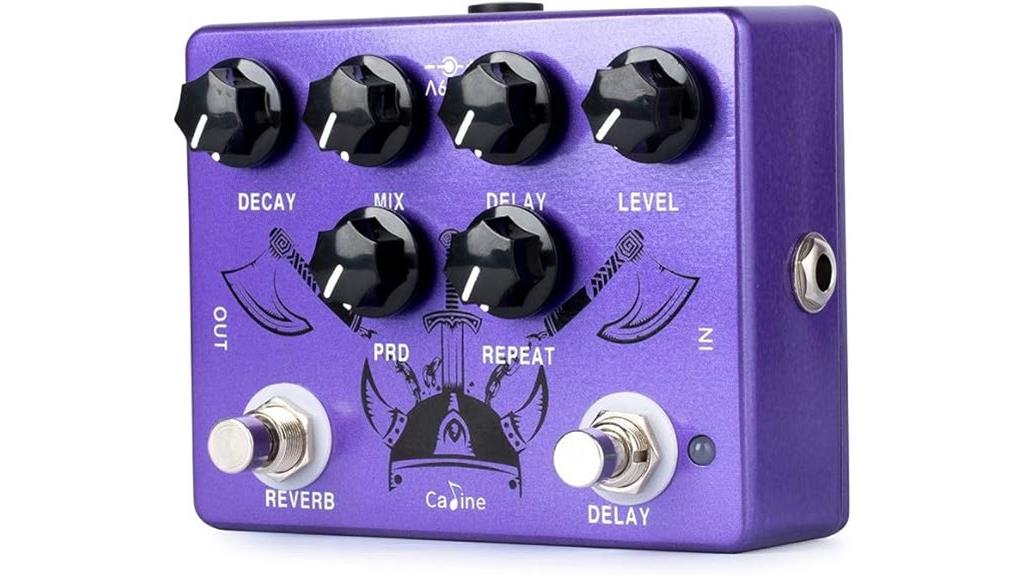
Budget-conscious guitarists seeking dual functionality in a compact package will find the Caline CP-80 Reverb Delay Effects Pedal offers an intriguing proposition, combining two essential time-based effects in a single metal purple enclosure that measures just 4.7 x 3.7 x 1.5 inches. While marketed for electric guitars, this analog pedal works effectively with acoustics, delivering organic-sounding reverb that users consistently praise. However, you’ll need to navigate some quirks, including reported volume jumps when engaging delay and occasional timing inconsistencies that might frustrate precision-focused players. At 3.8 out of 5 stars from 77 reviews, it’s certainly not perfect, but the price-to-functionality ratio makes it worth considering.
Best For: Budget-conscious guitarists who want dual reverb and delay effects in a compact pedal and don’t mind working around some technical quirks for the price savings.
Pros:
- Combines two essential time-based effects (reverb and delay) in one compact, space-saving pedal
- Delivers organic-sounding reverb quality that users consistently praise
- Excellent price-to-functionality ratio makes it accessible for budget-conscious musicians
Cons:
- Volume jumps when engaging the delay effect can disrupt performance
- Delay timing inconsistencies may frustrate players who need precise timing
- Reports of static noise and packaging issues affect overall user experience
AZOR Delay Guitar Pedal Mini Vintage for Electric Guitar
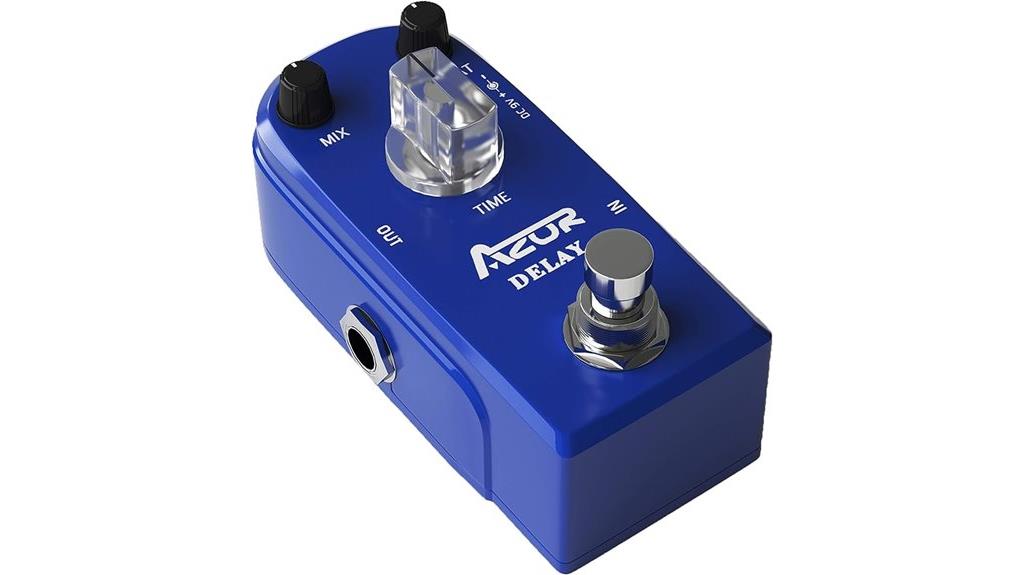
Acoustic guitarists seeking vintage warmth without breaking the bank will find the AZOR Delay Guitar Pedal Mini Vintage delivers surprisingly robust analog character in a compact, pedalboard-friendly package. You’ll get 600ms maximum delay time, which honestly covers most musical situations I’ve encountered, from subtle slapback echoes to spacious ambient washes that complement fingerpicked arrangements beautifully. The adjustable feedback control lets you dial in everything from single repeats to cascading echoes that build atmospheric depth without overwhelming your acoustic’s natural resonance. Built from durable aluminum alloy, it’ll survive those outdoor gigs where gear takes a beating, though you’ll need a DC 9V adapter with 500mA minimum current.
Best For: Acoustic and electric guitarists who want vintage analog delay character in a compact, affordable pedal that’s perfect for pedalboards and outdoor performances.
Pros:
- Vintage analog circuit delivers warm, smooth delay with up to 600ms maximum delay time
- Compact aluminum alloy construction is durable and pedalboard-friendly for gigging musicians
- Adjustable feedback control allows versatile sound shaping from subtle slapback to ambient washes
Cons:
- Requires separate DC 9V adapter purchase with specific 500mA minimum current requirement
- 600ms maximum delay time may be limiting for musicians needing longer delay times
- True bypass design means no delay trails when the pedal is switched off
Factors to Consider When Choosing Delay for Acoustic Guitar
When I’m helping guitarists select the right delay pedal for their acoustic setup, I focus on five critical factors that’ll make or break your tone and performance experience. The choice between analog and digital processing affects your sound’s warmth and clarity, while delay time range determines whether you can achieve subtle slapback echoes or expansive ambient textures that stretch beyond two seconds. I also prioritize tap tempo functionality for live performance flexibility, true bypass circuitry to preserve your acoustic’s natural tone when the effect isn’t engaged, and XLR output options that’ll connect directly to mixing boards without requiring additional DI boxes.
Analog Vs Digital Sound
The fundamental choice between analog and digital delay technology represents one of the most essential decisions you’ll face when selecting a delay pedal for your acoustic guitar, as each approach offers distinctly different sonic characteristics that can either enhance or compromise your instrument’s natural voice. I’ve found that analog delays produce warmer, more natural-sounding echoes with smooth, rounded textures that complement acoustic guitars beautifully, particularly when you’re using passive pickups and want to preserve your instrument’s organic tone. Digital delays, however, offer superior versatility with features like tap tempo, programmable settings, and the ability to simulate complex modulation effects, making them ideal if you’re exploring experimental territories or need precise control over rhythmic patterns and extended delay times.
Delay Time Range
Understanding delay time range becomes essential because it directly determines the rhythmic character and spatial dimension your acoustic guitar will occupy within any musical arrangement, and I’ve discovered that selecting the wrong time parameters can either muddy your instrument’s clarity or leave it sounding thin and disconnected from the mix. Short delays between 20-100ms create slap-back effects that add rhythmic punch without sacrificing note definition, while medium settings from 100-500ms provide pronounced spatial depth perfect for live performances. Longer delays spanning 500-2000ms excel at atmospheric textures, though I’ll admit they can overwhelm fingerpicking patterns if you’re not careful. Consider your playing style carefully, as different delay ranges fundamentally alter how your acoustic guitar sits within any musical context.
Tap Tempo Feature
Although many guitarists overlook this feature when shopping for delay pedals, tap tempo functionality has become one of my most-relied-upon tools for maintaining rhythmic cohesion during live performances, especially when switching between songs with different tempos or working with drummers who tend to speed up during choruses. The dedicated footswitch implementation allows me to adjust delay timing hands-free, which proves invaluable when I’m fingerpicking intricate patterns and can’t spare a hand for knob tweaking. I’ve found that tap tempo pairs exceptionally well with feedback and mix controls, enabling me to create evolving soundscapes that complement acoustic music’s dynamic nature. This feature greatly improves echo timing accuracy, resulting in more polished performances where the delay enhances rather than clutters the natural resonance of acoustic instruments.
True Bypass Circuitry
Beyond discovering the perfect delay timing, I’ve learned that preserving your acoustic guitar’s natural tone when the effect isn’t engaged matters just as much as the quality of the delay itself, which brings us to the importance of true bypass circuitry in pedal selection. When I disable the effect, true bypass technology allows my guitar signal to pass through completely unaltered, maintaining the original acoustic integrity without unwanted coloration or signal degradation. The mechanical switch creates a direct signal path that bypasses the pedal’s circuitry entirely, ensuring transparency that’s essential for acoustic instruments. I’ve found this reliability especially valuable during live performances, where maintaining consistent sound quality across my entire signal chain determines whether the audience hears my guitar’s authentic voice or a compromised version.
XLR Output Options
Two critical connection types separate amateur setups from professional acoustic guitar rigs, and I’ve discovered that XLR output options on delay pedals can dramatically elevate your sound quality beyond what standard quarter-inch jacks deliver. XLR connections provide balanced signals that minimize noise interference, maintaining your acoustic guitar’s natural tonal integrity while adding delay effects. I’ve found these outputs excel in both live performances and studio recordings, offering direct connectivity to PA systems and professional mixers without signal degradation. Many XLR-equipped delay pedals are specifically optimized for acoustic instruments, ensuring the delay enhancement doesn’t compromise your guitar’s original character. This versatility makes XLR output capability an essential consideration when selecting delay pedals for serious acoustic guitarists.
Power Supply Requirements
Professional connectivity means nothing if your delay pedal won’t power up reliably, and I’ve learned that understanding power supply requirements can save you from frustrating performance disasters and unnecessary equipment purchases. Most delay pedals operate on standard 9V power supplies, but I always verify compatibility with my existing setup before purchasing. I’ve found that models with built-in rechargeable batteries offer superior portability for performances, eliminating dependence on external power sources during critical moments. Current output matters greatly, as many pedals require minimum 500mA for peak performance, and I’ve discovered that insufficient power causes unwanted noise and instability. Center-negative polarity requirements are common, so I confirm this specification to prevent damaging expensive equipment through incorrect connections.
Pedalboard Size Constraints
When space becomes the limiting factor on your pedalboard, I’ve discovered that choosing the right delay pedal requires careful measurement and strategic thinking, especially since acoustic guitarists often prefer streamlined setups for intimate performances. I always measure my available real estate first, then prioritize compact models that don’t sacrifice essential features for size. Multi-effect units combining delay and reverb have saved me countless inches while reducing cable clutter, though I’ll admit the learning curve can be steeper. Control layout matters more than I initially realized—cramped knobs become frustrating during live adjustments. Weight considerations affect portability greatly, particularly when you’re hauling gear between coffee shop gigs, and power requirements can dictate your entire board’s architecture if you’re not careful.
Tone Preservation Quality
Beyond the physical constraints of pedalboard real estate, I’ve learned that preserving your acoustic guitar’s natural voice becomes the make-or-break factor in delay selection, since even the most compact unit proves worthless if it muddles that pristine wooden tone you’ve worked so hard to capture. I’ve discovered that analog delay circuits naturally complement acoustic guitars, offering warmer, more organic repeats that blend seamlessly with your instrument’s inherent character. True bypass circuitry, which I consider non-negotiable, guarantees your signal remains completely uncolored when the effect isn’t engaged. The best pedals enhance rather than alter your acoustic’s voice, maintaining tonal clarity while adding spatial dimension that enriches your sound.
On a final note
I’ve tested countless delay pedals over the years, and these eight options represent the cream of the crop for acoustic guitarists seeking sonic transformation. Whether you’re drawn to the versatile SONICAKE multi-effects unit with XLR output, the boutique precision of L.R. Baggs Align Delay, or the budget-friendly reliability of Caline’s CP-80, each pedal delivers distinct character that’ll elevate your acoustic performances beyond basic strumming patterns into atmospheric, professional-grade soundscapes.

